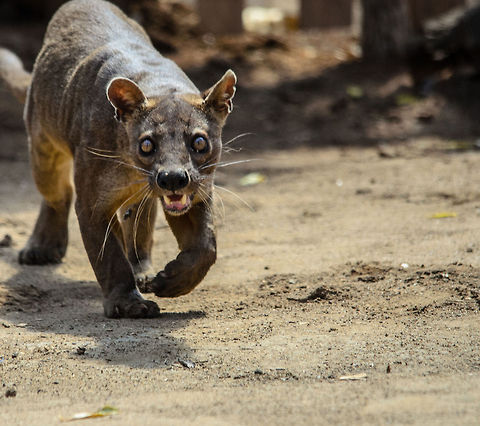
Appearance
The fossa appears as a diminutive form of a large felid, such as a cougar, but with a slender body and muscular limbs, and a tail nearly as long as the rest of the body. It has a mongoose-like head, relatively longer than that of a cat, although with a muzzle that is broad and short, and with large but rounded ears. It has medium brown eyes set relatively wide apart with pupils that contract to slits. Like many carnivorans that hunt at night, its eyes reflect light; the reflected light is orange in hue.Its head-body length is 70–80 cm and its tail is 65–70 cm long. There is some sexual dimorphism, with adult males being larger than females. Smaller individuals are typically found north and east on Madagascar, while larger ones to the south and west. Unusually large individuals weighing up to 20 kg have been reported, but there is some doubt as to the reliability of the measurements. The fossa can smell, hear, and see well. It is a robust animal and illnesses are rare in captive fossas.
Both males and females have short, straight fur that is relatively dense and without spots or patterns. Both sexes are generally a reddish-brown dorsally and colored a dirty cream ventrally. When in rut, they may have an orange coloration to their abdomen from a reddish substance secreted by a chest gland secretions, but this has not been consistently observed by all researchers. The tail tends to be lighter in coloration than the sides. Juveniles are either gray or nearly white.
Several of the animal's physical features are adaptions to climbing through trees. It uses its tail to aid in balance and has semi-retractable claws that it uses to climb trees in its search for prey. It has semiplantigrade feet, switching between a plantigrade-like gait and a digitigrade-like one. The soles of its paws are nearly bare and covered with strong pads. The fossa has very flexible ankles that allow it to readily grasp tree trunks so as to climb up or down trees head first or to leap to another tree. Captive juveniles have been known to swing upside down by their hindfeet from knotted ropes.
The fossa has several scent glands, although the glands are less developed in females. Like herpestids it has a perianal skin gland inside an anal sac which surrounds the anus like a pocket. The pocket opens to the exterior with a horizontal slit below the tail. Other glands are located near the penis or vagina, with the penile glands emitting a strong odor. Like the herpestids, it has no prescrotal glands.
One of the more interesting physical features of this species is its external genitalia. Males have an unusually long penis and baculum, reaching to between its forelegs when erect. The glans extends about halfway down the shaft and is spiny except at the tip. In comparison, the glans of felids is short and spiny, while that of viverrids is smooth and long. The female fossa exhibits transient masculization, starting at about 1–2 years of age, developing an enlarged, spiny clitoris that resembles a male's penis. The enlarged clitoris is supported by an os clitoridis, which decreases in size as the animal grows. Females do not have a pseudo-scrotum, but they do secrete an orange substance that colors their underparts, much like the secretions of males. Hormone levels do not seem to play a part in this transient masculization, as those levels are the same in masculinized juveniles and nonmasculinized adults. It is speculated that the transient masculization either reduces sexual harassment of juvenile females by adult males, or reduces aggression from territorial females. While females of other mammal species have a pseudo-penis, none is known to diminish in size as the animal grows.
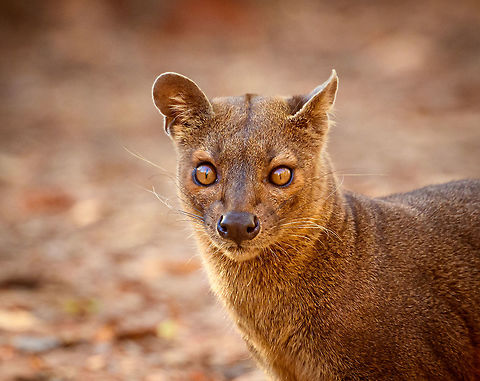
Naming
The genus name "Cryptoprocta" refers to how the animal's anus is hidden by its anal pouch, from the Ancient Greek words "crypto-" "hidden", and "procta" "anus". The species name "ferox" is the Latin adjective "fierce" or "wild." Its common name is spelled "fossa" in English or "fosa" in Malagasy, the Austronesian language from which it was taken, but some authors have adopted the Malagasy spelling in English. The word is similar to "posa" in the Iban language from Borneo, and both terms may derive from trade languages from 1600s. However, an alternative etymology suggests a link to another word that comes from Malay: "pusa" refers to the Malayan weasel. The Malay word "pusa" could have become "posa" for cats in Borneo, while in Madagascar the word could have become "fosa" to refer to the fossa.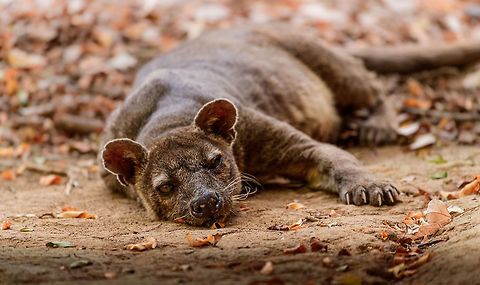
Distribution
The fossa has the most widespread geographical range of the Malagasy carnivores, and is generally found in low numbers throughout the island in remaining tracts of forest, preferring pristine undisturbed forest habitat. It is also encountered in some degraded forests, but in lower numbers. Although the fossa is found in all known forest habitats throughout Madagascar, including the western, dry deciduous forests, the eastern rainforests, and the southern spiny forests, it is seen more frequently in humid than in dry forests. This may be because the reduced canopy in dry forests provides less shade, and also because the fossa seems to travel more easily in humid forests. It is absent from areas with the heaviest habitat disturbance and, like most of Madagascar's fauna, from the central high plateau of the country.The fossa has been found across several different elevational gradients in undisturbed portions of protected areas throughout Madagascar. In the Réserve Naturelle Intégrale d'Andringitra, evidence of the fossa has been reported at four different sites ranging from 810 to 1,625 m. Its highest known occurrence was reported at 2,000 m; its presence high on the Andringitra Massif was subsequently confirmed in 1996. Similarly, evidence has been reported of the fossa at the elevational extremes of 440 m and 1,875 m in the Andohahela National Park. The presence of the fossa at these locations indicates its ability to adapt to various elevations, consistent with its reported distribution in all Madagascar forest types.
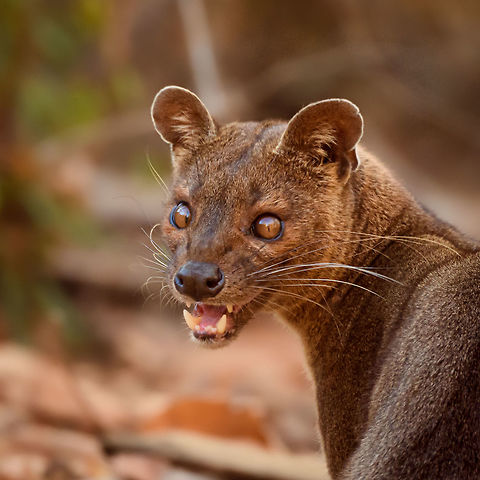
Behavior
The fossa is active during both the day and the night and is considered cathemeral; activity peaks may occur early in the morning, late in the afternoon, and late in the night. The animal generally does not reuse sleeping sites, but females with young do return to the same den. The home ranges of male fossas in Kirindy Forest are up to 26 km2 large, compared to 13 km2 for females. These ranges overlap—by about 30% according to data from the eastern forests—but females usually have separated ranges. Home ranges grow during the dry season, perhaps because less food and water is available. In general, radio-collared fossas travel between 2 and 5 kilometres per day, although in one reported case a fossa was observed moving a straight-line distance of 7 km in 16 hours. The animal's population density appears to be low: in Kirindy Forest, where it is thought to be common, its density has been estimated at one animal per 4 km2 in 1998. Another study in the same forest between 1994 and 1996 using the mark and recapture method indicated a population density of one animal per 3.8 km2 and one adult per 5.6 km2.Except for mothers with young and occasional observations of pairs of males, animals are usually found alone, so that the species is considered solitary. A 2009 publication, however, reported a detailed observation of cooperative hunting, wherein three male fossas hunted a 3 kg sifaka for 45 minutes, and subsequently shared the prey. This behavior may be a vestige of cooperative hunting that would have been required to take down larger recently extinct lemurs.
Fossas communicate using sounds, scents, and visual signals. Vocalizations include purring, a threatening call, and a call of fear, consisting of "repeated loud, coarse inhalations and gasps of breath". A long, high yelp may function to attract other fossas. Females mew during mating and males produce a sigh when they have found a female. Throughout the year, animals produce long-lasting scent marks on rocks, trees, and the ground using glands in the anal region and on the chest. They also communicate using face and body expression, but the significance of these signals is uncertain. The animal is aggressive only during mating, and males in particular fight boldly. After a short fight, the loser flees and is followed by the winner for a short distance. In captivity, fossas are usually not aggressive and sometimes even allow themselves to be stroked by a zookeeper, but adult males in particular may try to bite.
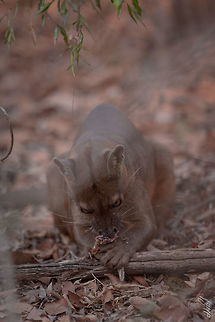
Habitat
The fossa has the most widespread geographical range of the Malagasy carnivores, and is generally found in low numbers throughout the island in remaining tracts of forest, preferring pristine undisturbed forest habitat. It is also encountered in some degraded forests, but in lower numbers. Although the fossa is found in all known forest habitats throughout Madagascar, including the western, dry deciduous forests, the eastern rainforests, and the southern spiny forests, it is seen more frequently in humid than in dry forests. This may be because the reduced canopy in dry forests provides less shade, and also because the fossa seems to travel more easily in humid forests. It is absent from areas with the heaviest habitat disturbance and, like most of Madagascar's fauna, from the central high plateau of the country.The fossa has been found across several different elevational gradients in undisturbed portions of protected areas throughout Madagascar. In the Réserve Naturelle Intégrale d'Andringitra, evidence of the fossa has been reported at four different sites ranging from 810 to 1,625 m. Its highest known occurrence was reported at 2,000 m; its presence high on the Andringitra Massif was subsequently confirmed in 1996. Similarly, evidence has been reported of the fossa at the elevational extremes of 440 m and 1,875 m in the Andohahela National Park. The presence of the fossa at these locations indicates its ability to adapt to various elevations, consistent with its reported distribution in all Madagascar forest types.
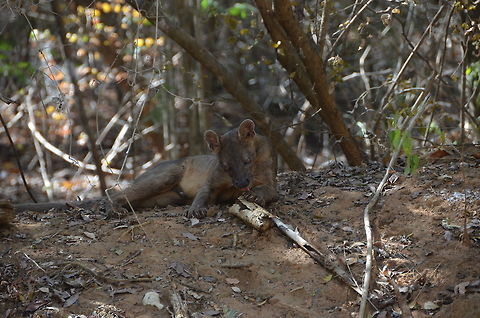
Reproduction
Most of the details of reproduction in wild populations are from the western dry deciduous forests; determining whether or not certain of these details are applicable to eastern populations will require further field research. Mating typically occurs during September and October, although there are reports of its occurring as late as December, and can be highly conspicuous. In captivity in the Northern Hemisphere, fossas instead mate in the northern spring, from March to July. Intromission usually occurs in trees on horizontal limbs about 20 m off the ground. Frequently the same tree is used year after year, with remarkable precision as to the date the season commences. Trees are often near a water source, and have limbs strong enough and wide enough to support the mating pair, about 20 cm wide. Some mating has been reported on the ground as well.As many as eight males will be at a mating site, staying in close vicinity to the receptive female. The female seems to choose the male she mates with, and the males compete for the attention of the female with a significant amount of vocalization and antagonistic interactions. The female may choose to mate with several of the males, and her choice of mate does not seem to have any correlation to the physical appearance of the males. To stimulate the male to mount her, she gives a series of mewling vocalizations. The male mounts from behind, resting his body on her slightly off-center, a position requiring delicate balance; if the female were to stand, the male would have significant difficulty continuing. He places his paws on her shoulders or grasps her around the waist and often licks her neck. Mating may last for nearly three hours. This unusually lengthy mating is due to the physical nature of the male's erect penis, which has backwards-pointing spines along most of its length. Fossa mating includes a copulatory tie, which may be enforced by the male's spiny penis. The tie is difficult to break if the mating session is interrupted. Copulation with a single male may be repeated several times, with a total mating time of up to fourteen hours, while the male may remain with the female for up to an hour after the mating. A single female may occupy the tree for up to a week, mating with multiple males over that time. Also, other females may take her place, mating with some of the same males as well as others. This mating strategy, whereby the females monopolize a site and maximize the available number of mates, seems to be unique among carnivores. Recent research suggests that this system helps the fossa overcome factors which would normally impede mate-finding, such as low population density and lack of den use.
The birthing of the litter of one to six takes place in a concealed location, such as an underground den, a termite mound, a rock crevice, or in the hollow of a large tree. Contrary to older research, litters are of mixed sexes. Young are born in December or January, making the gestation period 90 days, with the late mating reports indicating a gestational period of about six to seven weeks. The newborns are blind and toothless and weigh no more than 100 g. The fur is thin and has been described as gray-brown or nearly white. After about two weeks the cubs' eyes open, they become more active, and their fur darkens to a pearl gray. The cubs do not take solid food until three months old, and do not leave the den until they are 4.5 months old; they are weaned shortly after that. After the first year, the juveniles are independent of their mother. Permanent teeth appear at 18 to 20 months. Physical maturity is reached by about two years of age, but sexual maturity is not attained for another year or two, and the young may stay with their mother until they are fully mature. Lifespan in captivity is up to or past 20 years of age, possibly due to the slow juvenile development.
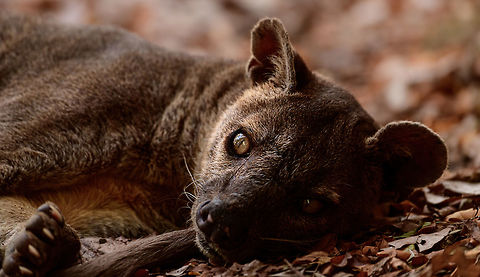
Food
The fossa is a carnivore that hunts small to medium-sized animals. One of eight carnivorous species endemic to Madagascar, the fossa is the island's largest surviving endemic terrestrial mammal and the only predator capable of preying upon adults of all extant lemur species, the largest of which can weigh as much as 90% of the weight of the average fossa. Although it is the predominant predator of lemurs, reports of its dietary habits demonstrate a wide variety of prey selectivity and specialization depending on habitat and season; diet does not vary by sex. While the fossa is thought to be a lemur specialist in Ranomafana National Park, its diet is more variable in other rain forest habitats.The diet of the fossa in the wild has been studied by analyzing their distinctive scats, which resemble gray cylinders with twisted ends and measure 10–14 cm long by 1.5–2.5 cm thick. Scat collected and analyzed from both Andohahela and Andringitra contained lemur matter and rodents. Eastern populations in Andringitra incorporate the widest recorded variety of prey, including both vertebrates and invertebrates. Vertebrates consumed ranged from reptiles to a wide variety of birds, including both understory and ground birds, and mammals, including insectivores, rodents, and lemurs. Invertebrates eaten by the fossa in the high mountain zone of Andringitra include insects and crabs. One study found that vertebrates comprised 94% of the diet of fossas, with lemurs comprising over 50%, followed by tenrecs, lizards, and birds. Seeds, which comprised 5% of the diet, may have been in the stomachs of the lemurs eaten, or may have been consumed with fruit taken for water, as seeds were more common in the stomach in the dry season. The average prey size varies geographically; it is only 40 grams in the high mountains of Andringitra, in contrast to 480 grams in humid forests and over 1,000 grams in dry deciduous forests. In a study of fossa diet in the dry deciduous forest of western Madagascar, more than 90% of prey items were vertebrates, and more than 50% were lemurs. The primary diet consisted of approximately six lemur species and two or three spiny tenrec species, along with snakes and small mammals. Generally, the fossa preys upon larger lemurs and rodents in preference to smaller ones.
Prey is obtained by hunting either on the ground or in the trees. During the non-breeding season the fossa hunts individually, but during the breeding season hunting parties may be seen, and these may be pairs or later on mothers and young. One member of the group scales a tree and chases the lemurs from tree to tree, forcing them down to the ground where the other is easily able to capture them. The fossa is known to eviscerate its larger lemur prey, a trait that, along with its distinct scat, helps identify its kills. Long-term observations of the fossa's predation patterns on rainforest sifakas suggest that the fossa hunts in a subsection of their range until prey density is decreased, then moves on. The fossa has been reported to prey on domestic animals, such as goats and small calves, and especially chickens. In captivity, the fossa consumes between 800 and 1,000 grams of meat a day. Food taken in captivity includes amphibians, birds, insects, reptiles, and small- to medium-sized mammals.
This wide variety of prey items taken in various rainforest habitats is similar to the varied dietary composition noted occurring in the dry forests of western Madagascar, as well. As the largest endemic predator on Madagascar, this dietary flexibility combined with a flexible activity pattern has allowed it to exploit a wide variety of niches available throughout the island, making it a potential keystone species for the Madagascar ecosystems.
References:
Some text fragments are auto parsed from Wikipedia.